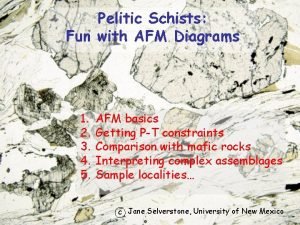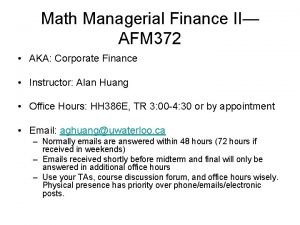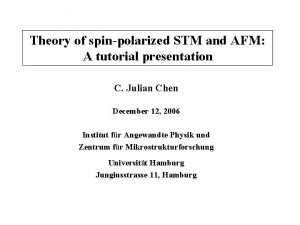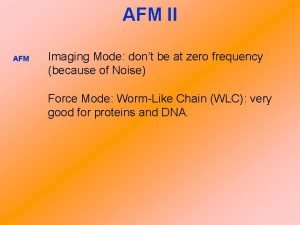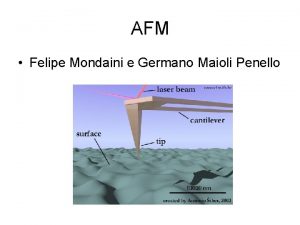How to analyze AFM images using Kodec Appearance







- Slides: 7

How to analyze AFM images using Kodec <Appearance> Double-click the Kodec icon for starting, and the following window will be displayed. Menu bar Toolbar Main screen AFM images will be displayed here. Z color bar The maximum and minimum heights seen in the image are shown by white and black. Basic information on images Scroll bar You can move frames displayed with dragging the scroll bar or with the arrow keys (→, ←) of the keyboard. File name display field You can move files by right double click or by the arrow keys (↓, ↑) of the keyboard. Position of AFM cantilever By dragging the boundary lines of the window, the size of main screen can be changed. File details < Basic operation > 1.File open XYZ coordinates of mouse cursor Displaying the XYZ coordinates of a mouse positon placed on the AFM image. • Open the target files using the toolbar icons or the Open Files button. ( ) • You can select and open multiple files at the same time (Ctr + A and mouse drag are useful). • When you select a folder in Open folder, all the files in the folder are opened. • By double clicking an AFM image file, you can also open the file by Kodec. • The opened files are displayed in the file name display field. You can move files to be displayed on the main screen by right double click or by the arrow keys (↓, ↑) of the keyboard. 2.Image processing 2. 1. Filtering ① Apply the Gaussian filter (Click on the Toolbar) to remove spike noises seen the images. To set the strength of the Gaussian filter, make right click on. Then, the Gauss. Filter sigma dialog appears, and you can set σ (0 - 20). The default value of σ is 0. 5. Typically, σ is set to 0. 5 – 0. 7. ② If vertical noises are seen in the AFM image, apply the X-Resonance noise filter (Menu -> Filtering > XResonance noise filter). When the Gaussian filter is applied, the value at the bottom of the bar becomes 0 Gauss. Filter Sigma dialog The value of σ can be changed up to 20. 1/6

2. 2. Tilt correction of the substrate ① For easy operation, select Auto Tilt ( ) from the tilt button, and the substrate slope is automatically corrected. Note: Auto Tilt would not work correctly if large objects are in the image. ② When Auto Tilt dose not work correctly, use Manual Tilt. After selecting Manual Tilt, make right click on the tilt button, and the Manual Tilt controller dialog appears. You can manually correct the substrate tilt. ③ Do not use X Line. Tilt. It may affect the image appearance. Manual Tilt controller dialog 2. 3. Confirm whether the tilt correction works correctly for the selected images ① Click to display the Rescaling dialog. ② By dragging button (typically at ~1/3 of the bar), change the color contrast to see the substrate tilt more clearly. Press the OK button and apply the contrast change to the selected images. ③ By displaying all selected images, confirm whether the tilt correction works correctly. If you see the tilt correction error, repeat 2. 2. ④ If the tilt correction is OK, click again to display the Rescaling dialog. Then, move button to the maximum position (at 255) and press the OK button. Reducing makes the color tone brighter Rescaling dialog 2. 4. Save as button> Check on Multi-frame >Click save button. ※ By default, bitmap is checked, but if you leave it as it is, you need to be careful because it will be saved separately for each frame. ・The initial setting of the save destination is the same folder as the original file. To change the save destination, specify the desired place from the Browse button and save. ・When saving only a part of the frames, with the start and end frames displayed, press the lower right arrow button to set the start and end frames, then save. When pressing here in the beginning and end frames the frame number is fixed on the arrow and the scroll bar of the selected part becomes blue Save as screen Check on Multi-frame Setting necessary a part of video 2/6

3.analysis 3 -1. Recording the coordinates of the vertex of a specific particle ①Open the processed video file. ②Set measurement conditions and others. Setting search range → Tool > velocity measurement > searching area(n×n) It can be set from 1 to 10. The surrounding (n × n) around the clicked pixel is set as the search range. Selection of analysis method → Tool > velocity measurement > method for analysis Check on center of mass. ③ Click velocity measurement to display the velocity measurement screen. Click this button to enter measurement mode ④ Left click on the pixel to measure. When clicked, the pixel portion of the highest point searched within the specified range around the click point becomes blue display. (When the specified range is n = 1, the clicked point becomes blue. ) Also, coordinate data such as the click point etc. are displayed on the velocity measurement screen for each item. Data of vertex coordinates of particles in each frame is obtained by repeating "click on the pixel to be measured → move to the next frame with the arrow key on the keyboard". ⑤ Click save the collected values to save the data. (Save as csv file format) (When the number of frames of moving pictures is large, you erase data accidentally, etc. It is good to save the data frequently, unfamiliar. ) Set to measurement mode and click, the pixel of highest point turns blue. Every click, the coordinate data of the click point, highest point, center of mass, average (X only) is displayed. velocity measurement screen < Commonly used icons during analysis > delete the last data Restore the previous click point and data. (Since it may cause an error, you should not use it much) Delete displaying points Delete the click point. (The blue point accumulates, so if the movement of particles is small, the part you want to measure becomes difficult to see. Therefore, it is easy to measure when you erase frequently. ) Delete collected values Erase the data. (It is right beside button but when you press it by mistake all the data disappears, so you need to be careful. ) Save the collected values Save the data. 3/6

< Measurement example > (ex. ) Measure and calculate the maximum height of two domains and the distance between domains. 1. Image processing Perform image processing based on basic operation, create and save as another file. Height 1 Distance Height 2 Gaussian filter + Auto tilt The original image The upper left is a little dark, the substrate is tilted Modified image The rough feeling became a little smooth, The brightness of the background became uniform, and the inclination of the substrate was corrected 2. Measure the height of the first domain Open the image processed file, enter the measurement mode, click on the frame closest to the brightest pixel of the first domain for each frame. The search area is set to n = 5. Click Max point → repeat the move to the next frame with the arrow keys. . . Lastly save the data. (ex) Result of clicking on frame 1 to 50 The pixel turns blue and data accumulates. 3. Measure the height of the second domain Likewise, click on the point closest to the brightest pixel in the second domain to obtain the coordinate data of the highest point. 4. Measure the height of Back ground Because the height of the back ground may be different for each frame, measure the height of the back ground for each frame. With the search range set to the maximum (n = 10), click on the part with as little as possible and obtain the average data of the Z coordinate within the search range (displayed on the far right of the velocity measurement screen) You can click anywhere except here. In order to set the search range to the maximum, if there is a possibility of selecting a molecule if it is too close to a molecule, it is impossible to approach too much. 4/6

5. Excel etc. are used to calculate the height of each domain and the distance between domains. Maximum height of each domain) = (z coordinate of highest point of each domain) - (average of back ground) (Distance between domains) = Distance is calculated from xy coordinates of highest point of each domain. * When calculating the length such as distance, it is necessary to calculate as the final value by considering the value of pixel and range of frame.

< Example > l Me. CP 2 Measure the maximum height of MBD and C-term and the distance between MBD and C-term. Distance Starting point of C-term highest point MBD C-term MDB highest point Me. CP 2 Each maximum height is the Z coordinate of the highest point, and the distance is calculated from XY coordinates. Actual image Click the Max point (n = 5) of C-term of MBD and the starting point (n = 1) of C-term. The values in () are set values of the search range. l Trx-NTAIL Measure the maximum height of large and small two domains and the distance between domains. Distance Trx-NTAIL Click Max point of each domain. Domain to be measured Image where two domains exist near distance. Max point of the small domain is clicked from the upper right. An image whose movement is fast and has afterimages left. In that case, check the images before and after, and judge which point should be measured. In the case of this image, the small domain to measure was upper left. After image 6/6

< Notes on data acquisition and tips > l When the unintended highest point is close to the target point, such as when the two domains are in close range or when dust is attached, if the search range is large, the target highest point data can not be obtained accurately Sometimes. Therefore, it is advisable to reduce the setting of the search range or to shift the click point so that dust does not enter. If you click on this side, there is a possibility of acquiring the data of the lower left point. There are two Highest points at short distance. If the desired point is on the upper right, click on the direction to the upper right slightly (from the opposite direction to the lower left point) to obtain the desired point data. l If you do not know where you want the point, such as playing back the movie or comparing it with the frames before and after, it becomes easy to understand. 5/6

